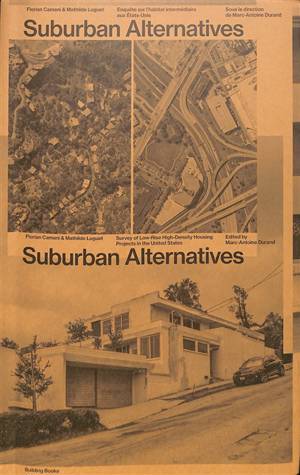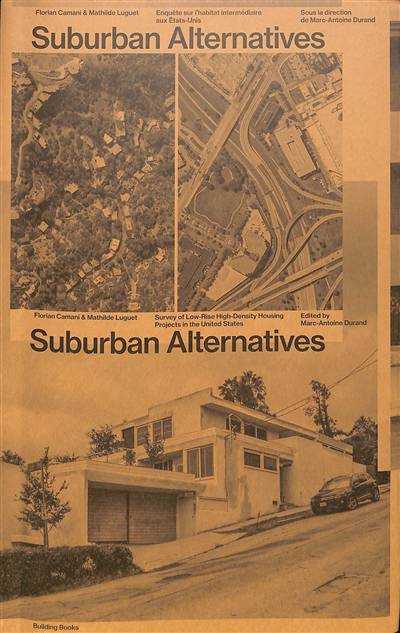
- Retrait gratuit dans votre magasin Club
- 7.000.000 titres dans notre catalogue
- Payer en toute sécurité
- Toujours un magasin près de chez vous
- Retrait gratuit dans votre magasin Club
- 7.000.0000 titres dans notre catalogue
- Payer en toute sécurité
- Toujours un magasin près de chez vous
Suburban alternatives
enquêtes sur l'habitat intermédiaire aux Etats-Unis
Florian Camani, Mathilde LuguetDescription
Suburban Alternatives
Enquête sur l'habitat intermédiaire aux États-Unis
Low-rise, high-density. Aux États-Unis, depuis l'exposition Another Chance for Housing : Low-Rise Alternatives en 1972 au MoMA, l'expression désigne des ensembles de logements groupés conservant des caractéristiques proches de l'habitat individuel, mais dont la densité autorise la présence de services communs et d'aménités permettant de réduire la consommation de foncier. La compacité du bâti limite la consommation d'énergie et favorise les mutualisations, tout en offrant un cadre de vie proche de la nature. Ces réalisations hybrides génèrent, en outre, une variété de typologies de logements et de formes d'agroupement. Elles questionnent un urbanisme du dehors constitutif de l'ethos américain et ouvrent à des alternatives plus vertueuses, plus écologiques, qui font sens aujourd'hui.
Formes de résistance au modèle archi-dominant de la maison individuelle, ces propositions d'habitats intermédiaires ont accompagné le développement suburbain américain de 1920 à nos jours. Elles témoignent du regard critique des architectes quant au mode de développement purement horizontal de leur territoire. Ainsi, Rudolph Schindler, Richard Neutra, Al Beadle, Gregory Ain contribuaient déjà, par certaines de leurs réalisations, à la recherche d'une autre modernité moins individualiste.
Après un voyage d'étude de trois mois, c'est par un atlas regroupant cinquante cas, répartis sur la totalité du territoire états-unien, que Florian Camani et Mathilde Luguet livrent leur propos : une boîte à outils riche et inventive, mise en perspective, avec Marc-Antoine Durand, par les textes de chercheurs français et américains, spécialistes des territoires suburbains américains. Suburban Alternatives se veut une contribution au débat sur la densité habitée aux États-Unis, et une réflexion ouverte sur le devenir du pavillonnaire en général.
Suburban Alternatives
Survey of Low-Rise High-Density Housing Projects in the United States
Low-rise, high-density : in the United States, since the 1972 exhibition Another Chance for Housing : Low-Rise Alternatives at the MoMA, the expression refers to the ensembles of grouped housing units that maintain characteristics of the individual home, but whose density facilitates collective services and amenities and thereby reduces the consumption of land. The compactness of the building footprint limits energy consumption and promotes sharing, all while offering a living environment in close proximity to nature. These hybrid projects also generate a variety of housing typologies and forms of agglomeration. They propose an urbanism linked to the American ethos and open up more sustainable, more ecological alternatives, suited to current times.
As forms of resistance to the dominant architectural model of the single-family home, these proposals for low-rise high-density housing have accompanied suburban development in the United States from the 1920s until today. They bear witness to architects' critical view of purely horizontal modes of developing land. In this way, certain projects by Rudolph Schindler, Richard Neutra, Al Beadle, and Gregory Ain made early contributions to the search for an alternative, less individualistic modernity.
Following a study trip of three months, Florian Camani and Mathilde Luguet deliver their observations through an atlas of fifty projects from across the United States : a set of rich and inventive tools, contextualized by essays from French and American researchers specialized in suburban areas and coordinated by Marc-Antoine Durand. Suburban Alternatives is both a contribution to the debate on housing density in the United States and a general, open reflection on the future of suburban living.
Spécifications
Parties prenantes
- Auteur(s) :
- Traducteur(s):
- Editeur:
Contenu
- Nombre de pages :
- 288
- Langue:
- Français, Anglais
Caractéristiques
- EAN:
- 9782492680168
- Date de parution :
- 15-06-24
- Format:
- Livre broché
- Dimensions :
- 190 mm x 300 mm
- Poids :
- 801 g

Les avis
Nous publions uniquement les avis qui respectent les conditions requises. Consultez nos conditions pour les avis.






